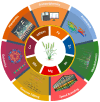Micronutrient Biofortification in Wheat: QTLs, Candidate Genes and Molecular Mechanism
- PMID: 40076800
- PMCID: PMC11900071
- DOI: 10.3390/ijms26052178
Micronutrient Biofortification in Wheat: QTLs, Candidate Genes and Molecular Mechanism
Abstract
Micronutrient deficiency (hidden hunger) is one of the serious health problems globally, often due to diets dominated by staple foods. Genetic biofortification of a staple like wheat has surfaced as a promising, cost-efficient, and sustainable strategy. Significant genetic diversity exists in wheat and its wild relatives, but the nutritional profile in commercial wheat varieties has inadvertently declined over time, striving for better yield and disease resistance. Substantial efforts have been made to biofortify wheat using conventional and molecular breeding. QTL and genome-wide association studies were conducted, and some of the identified QTLs/marker-trait association (MTAs) for grain micronutrients like Fe have been exploited by MAS. The genetic mechanisms of micronutrient uptake, transport, and storage have also been investigated. Although wheat biofortified varieties are now commercially cultivated in selected regions worldwide, further improvements are needed. This review provides an overview of wheat biofortification, covering breeding efforts, nutritional evaluation methods, nutrient assimilation and bioavailability, and microbial involvement in wheat grain enrichment. Emerging technologies such as non-destructive hyperspectral imaging (HSI)/red, green, and blue (RGB) phenotyping; multi-omics integration; CRISPR-Cas9 alongside genomic selection; and microbial genetics hold promise for advancing biofortification.
Keywords: biofortification; iron; micronutrient deficiency; selenium; wheat; zinc.
Conflict of interest statement
The authors declare no conflicts of interest. The funders had no role in the design of the study; in the collection, analyses, or interpretation of data; in the writing of the manuscript; or in the decision to publish the results.
Figures


Similar articles
-
Biofortification and bioavailability of Zn, Fe and Se in wheat: present status and future prospects.Theor Appl Genet. 2021 Jan;134(1):1-35. doi: 10.1007/s00122-020-03709-7. Epub 2020 Nov 2. Theor Appl Genet. 2021. PMID: 33136168 Review.
-
Dissection of Molecular Processes and Genetic Architecture Underlying Iron and Zinc Homeostasis for Biofortification: From Model Plants to Common Wheat.Int J Mol Sci. 2020 Dec 5;21(23):9280. doi: 10.3390/ijms21239280. Int J Mol Sci. 2020. PMID: 33291360 Free PMC article. Review.
-
Wheat Biofortification: Utilizing Natural Genetic Diversity, Genome-Wide Association Mapping, Genomic Selection, and Genome Editing Technologies.Front Nutr. 2022 Jul 12;9:826131. doi: 10.3389/fnut.2022.826131. eCollection 2022. Front Nutr. 2022. PMID: 35938135 Free PMC article. Review.
-
Harnessing genetic diversity in wheat to enhance grain nutrition and yield for biofortification breeding.Biol Res. 2025 Jun 4;58(1):33. doi: 10.1186/s40659-025-00606-5. Biol Res. 2025. PMID: 40462198 Free PMC article.
-
Single- and multi-trait genomic prediction and genome-wide association analysis of grain yield and micronutrient-related traits in ICARDA wheat under drought environment.Mol Genet Genomics. 2023 Nov;298(6):1515-1526. doi: 10.1007/s00438-023-02074-6. Epub 2023 Oct 18. Mol Genet Genomics. 2023. PMID: 37851098 Free PMC article.
References
-
- FAO Children: Improving Survival and Well-Being. [(accessed on 10 January 2024)]. Available online: https://www.who.int/news-room/fact-sheets/detail/children-reducing-morta....
-
- Rathan N.D., Krishna H., Ellur R.K., Sehgal D., Govindan V., Ahlawat A.K., Krishnappa G., Jaiswal J.P., Singh J.B., Sv S., et al. Genome-Wide Association Study Identifies Loci and Candidate Genes for Grain Micronutrients and Quality Traits in Wheat (Triticum aestivum L.) Sci. Rep. 2022;12:7037. doi: 10.1038/s41598-022-10618-w. - DOI - PMC - PubMed
Publication types
MeSH terms
Substances
Grants and funding
LinkOut - more resources
Full Text Sources

